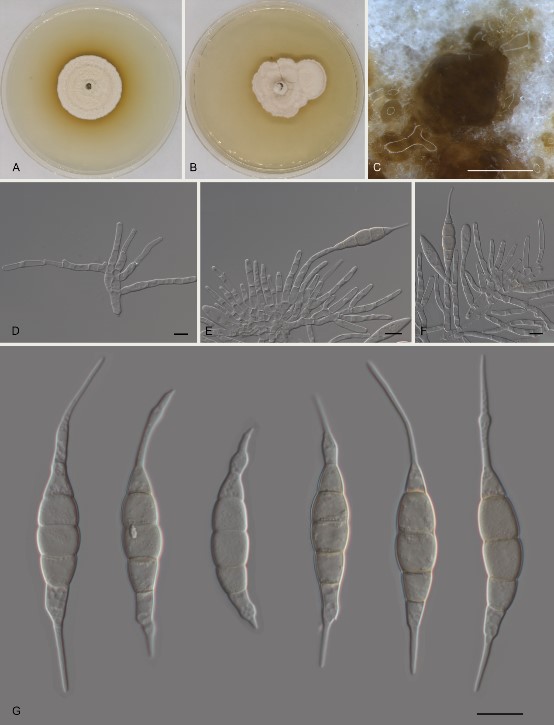Monochaetia lithocarpicola N. Jiang, in Jiang, Voglmayr, Xue, Piao & Lia, Microbiology Spectrum: 10.1128/spectrum.00042-23, 7 (2023)
Index Fungorum number:IF 841306; MycoBank number: MB 841306; Facesoffungi number: FoF 11687.
Etymology – named after the host genus, Lithocarpus.
Diagnosis – morphologically distinct from the other Monochaetia species by hyaline conidia.
Pathogenic to host leaves. Asexual state: Conidiomata in culture sporodochial, aggregated or solitary, erumpent, pulvinate, brown, 300–700 μm diam., exuding brown conidial masses. Conidiophores septate and branched, hyaline, thin-walled. Conidiogenous cells hyaline, smooth, cylindrical to subcylindrical, annelidic, 5–22.5 × 2–3.5 μm, mean ± SD = 15.8 ± 4.5 × 2.9 ± 0.4 μm. Conidia fusoid, straight or slightly curved, 4-septate, smooth, constricted at the septa, (31–)31.5–34(–35) × (7.5–)8–8.5(–9) μm, mean ± SD = 33 ± 1.2 × 8.3 ± 0.4 μm (n = 50), L/W = 3.5–4.5; basal cell obconic with a truncate base, thin-walled, hyaline, (5–)5.5–7.5(–8) μm; median cells 3, trapezoid or subcylindrical, pale brown, thick-walled, the first median cell from base (5.5–)6–7(–7.5) μm long, the second cell (6–)6.5–8.5 μm long, the third cell (6–)6.5–8.5(–9) μm long, together (18–)19–22.5(–23) μm long; apical cell conic with an acute apex, thin-walled, hyaline, 5.5–6.5 μm long; basal appendage single, unbranched, tubular, centric, straight or slightly bent, (6.5–)7–12.5(–13.5) μm long, mean ± SD = 9.7 ± 2.6 μm; apical appendage single, unbranched, tubular, centric, bent, (12–)13–23(–24) μm long, mean ± SD = 18 ± 4.8 μm. Sexual morph unknown.
Culture characteristics – colonies on MEA flat, with ruffle sag on the surface and undulated edge, white to pale luteous, reaching 25 mm in diameter after 10 days at 25°C, forming brown conidiomata with brown conidial masses; colonies on PDA flat, spreading, with entire edge, white to pale luteous, reaching 25 mm in diameter after 10 days at 25°C, forming brown conidiomata with brown conidial masses.
Material examined – China, Guangdong Province, Qingyuan City, Yangshan County, Guangdong Nanling Nature Reserve, on diseased leaves of Lithocarpus glaber (Fagaceae), 4 December 2019, Shang Sun (holotype CAF 800018 = JNH0014; ex-holotype culture CFCC 54509); ibid., culture CFCC 54448.
Distribution – China
Sequence data – ITS: OK339751 (ITS1/ITS4); LSU: OK339780 (LROR/LR5); tef1: OK358479 (EF1-728F/EF2); tub2: OK358488 (Bt2a/Bt2b)
Notes – In our phylogenetic analyses, M. lithocarpicola is the closest relative of Monochaetia massachusettsianum, which was isolated from air in the United States and for which the natural host is, therefore, unknown. However, M. lithocarpicola is distinguished from M. massachusettsianum by obviously longer conidia (31 to 35 μm versus 23 to 30 μm in M. massachusettsianum).

Fig. 4. Morphology of Monochaetia lithocarpicola (CFCC 54509). A. Colony on PDA after 10 d at 25 °C; B. Colony on MEA after 10 d at 25 °C; C. Conidioma formed on PDA; D–F. conidiogenous cells giving rise to conidia; G. conidia. — Scale bars: C = 300 μm; D–G = 10 μm.
